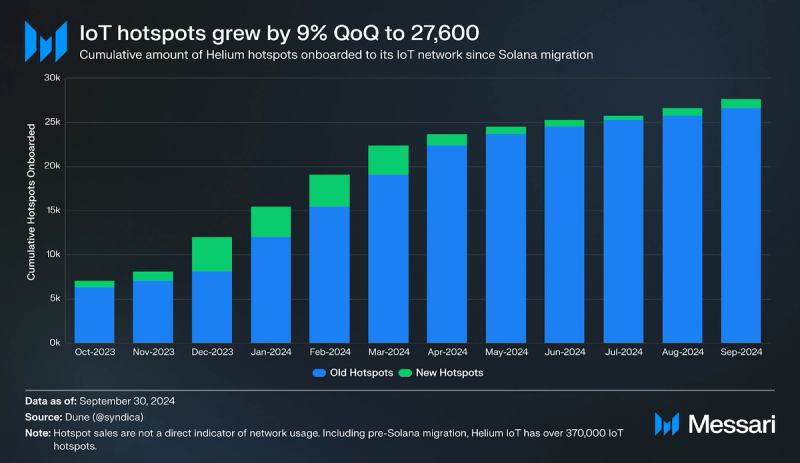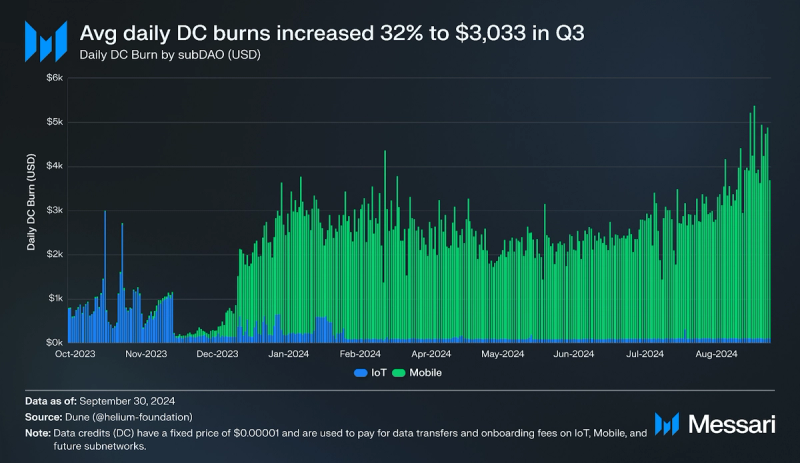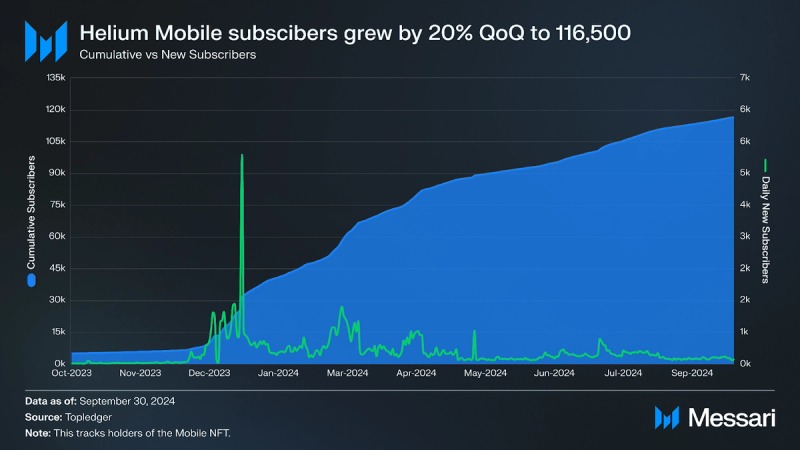Key Insights
- At the end of Q3, the Helium Network transferred over 88,000 GB of Offloaded Data from major mobile carriers in the US, a 10,202% increase.
- By the end of Q3, over 116,000 users have subscribed to Helium Mobile for unlimited talk and text messaging for $20/month.
- Mobile hotspots grew by 32% QoQ to 21,800, and IoT hotspots grew by 9% to 27,600 (since Solana migration).
- Passed in Q4, HIP 138 could bring the network back to its single token design – driving more utility to the HNT token.
Primer
Helium (HNT) is a decentralized wireless network that connects low-power Internet of Things (IoT) devices and mobile services. Launching in 2019, Helium launched an IoT network on its purpose-built blockchain. Users could send data to and from the Internet, and protocol miners were rewarded with HNT tokens for providing wireless network coverage. Initially, the network only offered LoRaWAN connectivity to IoT devices.
After the approval of a governance proposal (HIP-70) over a year later, it migrated blockchain operations to Solana. Helium operates on a subDAO framework laid out in Helium Improvement Proposals (HIPs) 51, 52, and 53. Helium’s mobile subnetwork has gained traction through Helium Mobile’s telecom carrier. Starting in June 2024, Helium’s carrier offloading program has been a primary growth driver. The program allows users of legacy telecom companies to use Helium hotspots when in areas of sufficient coverage. In its first full quarter, the program offloaded over 88,000 GB of data to Helium Hotspots. Helium’s IoT network has found traction in various use cases, with some notable examples including its use in flood detection in Porto, Portugal, and in monitoring humidity and temperature for museums. Throughout its lifetime, Nova Labs, Helium’s founding operating company, has raised over $360 million for Helium, with its most recent raise attracting $200 million of investment in March 2022. For a full primer on the Helium Network, refer to our Initiation of Coverage report.
Website / X (Twitter) / Discord
Key Metrics
Performance Analysis
Financial


In Q3, HNT’s circulating market cap increased by 124% QoQ to $1.3 billion from $574 million. HNT’s price grew by 119% to $7.54 from $3.44. HNT is the network’s primary token. It’s distributed from the Helium DAO to subDAOs based on performance and engagement (i.e., utility score).
There are three main functionalities for the Helium Network token (HNT):
- Buy Data Credits (DCs) to access subnetwork functionalities: HNT can be burnt to receive Data Credits through the Helium Wallet App, Helium CLI, or Data Credit Portal. The value of a DC is fixed at $0.00001. The amount of DC that users will receive from burning HNT will be determined by the current price of HNT in USD.
- Stake to receive veHNT and gain governance votes for the Helium DAO: Since the Helium Network is acting as an overarching structure for these networks (i.e., subDAOs) that are created, it needs its own governance mechanism. Members of the DAO (i.e., owners of HNT) can participate in the voting processes for the HIPs by staking their HNT and receiving proportional voting power.
- Offer redeemability for IOT or MOBILE hotspot hosts. This is subject to change with the implementation of HIP 138.
There is no specified buyback for HNT, but it is necessary because the only way to buy DCs is to burn HNT. This token emission design, called burn and mint equilibrium, ensures that the network usage is aligned with the amount of HNT in circulation. To ensure that miners are always incentivized to transmit data securely through the network, HIP 20 introduced Net Emissions in August 2021. This mechanism is designed to give the network HNT rewards in perpetuity by monitoring the number of HNT burned for DC in a given epoch and adding the number of HNT to mint that epoch. If less than the planned amount of HNT is burnt for DCs on a given day, this mechanism will re-mint and distribute the total amount of HNT into the subnetwork’s treasury. The fixed net emissions daily epoch cap is 1,643.52 HNT.
Network
Hotspots

In Q3, Helium Mobile’s hotspots grew by 32% QoQ to 21,800 from 16,500. The growth outpaced IoT’s growth by over 20% due to driving demand for Helium Mobile’s phone plan. Helium Mobile’s $20 per-month unlimited plans are considerably less than the average three-figure plans that categorize American telecom. It also enables users to save even more through its Discovery Mapping feature, which rewards users in MOBILE for sharing their location. In addition to its ability to attract suppliers, Helium Mobile seems primed to continue attracting new users (regardless of crypto-nativeness) to its telecom network.
The network’s power was shown during the Hurricane disaster in Helene, North Carolina, which left many people without electricity and water at the end of September. Helium hotspots stayed active during the disaster and gave people access to 5G coverage. The team also shipped out kits, including Starlink, that could be used for emergency coverage.

In Q3, IoT hotspot growth slowed to 9%, ending the quarter with 27,600 hotspots onboarded since the Solana migration in early 2023, with several thousand of them coming from gamers. Before the migration, the network had over 342,000 active hotspots, bringing the network total to over 370,000.
When Helium first launched the IoT product, the rewards offered to hotspot owners reached thousands of dollars per month. By nature, the Proof-of-Coverage (PoC) algorithm hurts hotspot rewards if more hotspots provide coverage around it. Therefore, as more people bought hotspots, the rewards that were once assumed decreased significantly. The rate of adoption of the hotspots for the IoT network was parabolic.
However, usage has yet to keep up with supply-side adoption. Despite DCs also being used to cover the onboarding fees associated with setting up a hotspot (e.g., it costs $10 in DCs to set up the location of a hotspot in the network), the data transfer portion of the DCs that were getting burnt didn’t surpass a couple of hundred dollars per day. To summarize, Helium had managed to set up the infrastructure to provide the LoRaWAN connectivity but hasn’t yet found sufficient demand for it.
Helium’s website shows the network’s coverage with both types of hotspots. Most of the coverage centers around large North America, Europe, and Southeast Asia cities.
Data Credits

Data credits (DC) have a fixed price of $0.00001 and are used to pay for data transfers and onboarding fees on IoT, Mobile, and future subnetworks. Total DC burns ended at $279,000 for Q3. The average daily DC burns increased by 32% to $3,033 from $2,307. $2,937 came from the Mobile subDAO, representing 97% of DC burns for the quarter, and $96 came from the IoT subDAO. Since February 22, daily DC burns for the IoT subDAO have slowly grown, with the peak at $110.
There was an initial spike in usage in August 2023, in which the DC burns reached a maximum of $6,270 per day. Despite this, the DC consumption followed even as hotspot HNT rewards started decreasing. On November 27, 2023, the dollar value of DCs burned was $156.
Mobile Subscribers

When onboarding to Helium Mobile, users are sent a Mobile NFT to their wallet, which can be used to track Helium Mobile subscribers. In Q3, subscribers grew by 20% to 116,500 from 96,900. The significant spike in December was when Helium Mobile became available to the public. It is important to note, that some of these numbers could be fraudulent since we are only tracking NFT holders.
Helium Mobile’s product offering seems to have more adoption than its closest competitor, World Mobile (110K at the time of writing). In May 2024, Helium announced the rollout of its Group Family Plans, offering unlimited talk, text, and data nationwide for $20 per month. In the United States, this positions Helium Mobile as a cheaper alternative to the $30 for 5GB data plan that World Mobile offers. Helium also differs in its T-Mobile partnership that promises “Dynamic Coverage,” where Helium Mobile users connect to Helium hotspots when possible and connect to outsourced coverage provided by T-Mobile when Mobile hotspot coverage is unavailable. The growth is expected to continue with its partnership with the newly announced Solana Mobile Seeker phone. Each phone comes with 4 months of free Helium Mobile service.
Carrier Offloading

Starting June 18 this year, Helium partnered with legacy telecom companies to use Helium hotspots when users are in areas of sufficient coverage. To date, Helium has partnered with three carriers to offload user data. Offloaded data is the amount of production data subscribers from other carriers have transferred through the Helium Network. In Q3, the data offloaded grew by 10,202% to 88,000 GB from 854 GB.
Carrier 2 ended the quarter with the most offloaded data at 73,700 GB, a 53,300% increase. Carrier 1 ended with 14,200 GB offloaded, a 1,880% increase. Carrier 3, which only started on September 5, ended the quarter with 57 GB offloaded.
This is one of the biggest growth opportunities any Web3 company has ever had. Helium Mobile already has plans to onboard more carriers to the program. Anyone can view up to date stats at Hellohelium.com.
Paid Traffic

Paid traffic is the amount of data paid for that is sent through Helium Mobile Hotspots. In Q3, the average daily mobile paid traffic grew by 32.5% QoQ to 5,900 GB from 4,400 GB. The growth brings the total paid traffic to 1.5 million GB of data sent through a hotspot. This is a 57% increase QoQ – 941,200 GB had been sent at the end of Q2. As one of the main revenue drivers for the Helium network, this metric is expected to continue growing as the protocol grows.
Qualitative Analysis
Technical Improvements
In our Initiation of Coverage report, we highlighted three Helium Improvement Proposals (HIP):
- HIP 111— Increase Mobile Hotspot Coverage: This proposal proposes that Access Points that have transferred a lot of data over the last seven epochs (i.e., 1 MB within a 7-epoch rolling window) are eligible for Boosted Coverage Points (CPs). This would increase the amount of MOBILE they receive. This proposal has been closed.
- HIP 110— Proxy Voting: Soon to be deployed to enable proxy voting, this HIP will allow owners of veHNT, veIOT, and veMOBILE to delegate their vote to another participant for a limited time. This proxy assignment can be recursive since the implementation is rooted in an NFT delegation contract. In other words, someone assigned someone else’s vote can, in turn, delegate that vote to someone else. This will move voting power to the most active representatives. This proposal has been deployed and is now live.
- HIP 116— Lower Barriers to Entry for Device Owners: Recently approved, this HIP will reduce the price network operators pay to bring devices onto the network. Previously, operators would have to purchase a block of device addresses (DevAddr) to assign to devices; eight DevAddr would cost $800. This cost is a barrier to entry, especially for those who self-host their LNS. After the proposal approval, the cost of eight DevAddr decreased to $100. This was approved by the time the initial report came out.
During Q3, many other proposals were discussed and voted on:
- HIP 122— Amend Service Provider Hex Boosting: This HIP changes the minimum time for Service Provider Hex Boosting to 3 months, and future boost creation is limited to a maximum of 10x rewards. This HIP has been deployed.
- HIP 125— Temporary Anti-Gaming Measures for Boosted Hexes: This HIP introduces a 6-month temporary measure allowing service providers to prevent gaming in boosted hexes. This HIP has been deployed.
- HIP 119— Closing Gaming Loopholes Within the MOBILE Network: This HIP is the permanent fix to HIP 125. This HIP has been deployed.
- HIP 128 — Energy Subnetwork: This HIP proposes creating a new ENERGY subnetwork within the Helium ecosystem. This subDAO would participate in the energy market with solar power production and battery storage. This HIP has been approved and is awaiting deployment.
- HIP 129— MOBILE Carrier Beta: This HIP proposes automatically opting in all MOBILE Wi-Fi hotspots to the Beta carrier offloading program. Operators can choose to opt out if desired. This HIP has been deployed.
- HIP 130— Data-only MOBILE Hotspots: Data-only hotspots are any Wi-Fi hotspot supporting Passpoint authentication that does not need to be purchased from a certified Helium Hotspot vendor. This HIP has been deployed.
- HIP 131— Bridging Gap Between Verification Mappers and Anti-Gaming Measures: This proposal expands on HIPs 125, 118, and 103. This HIP has been deployed.
HIP 138 and Helium v3 Discussion
The Helium v3 concept, introduced in Q3 by Nova Labs, outlines a comprehensive proposal to advance the Helium Network by addressing current limitations and preparing it for enhanced scalability, security, and broader adoption. Following the initial proposal, community feedback led to the refinement of several key aspects, resulting in the Helium v3.0.1 update.
The discussion of Helium v3 then expanded to HIP 138, which was proposed in Q4. The most significant change would be to return the network to one token, HNT. The HIP 138 proposal passed in Q4, and a more in-depth analysis will be provided in the Q4 report. The proposal will be implemented in January 2025.
Other important updates:
- Anchorage Digital supports HNT in its institutional self-custody wallet.
- Helium Mobile announced its expansion of coverage into Mexico. Leon, Tijuana, Guadalajara, Puebla, Toluca, and Oaxaca all received boosted locations on launch.
- Helium Mobile announced its partnership with USC Athletics. Helium will sponsor football and basketball home games during the 2024-2025 seasons, offering stadium branding, planned activations, and on-site giveaways for fans.
Closing Summary
Helium’s Q3 2024 demonstrated strong momentum in network expansion, technical upgrades, and enterprise partnerships. The network experienced a remarkable 10,202% growth in carrier offloaded data, with over 88,000 GB transferred through partnerships with major telecom providers. The expansion of Helium Mobile to over 116,000 subscribers and the growth in mobile and IoT hotspots highlights the increasing adoption of Helium’s decentralized wireless offerings.
Technical advancements, including the ongoing discussions around HIP 138 to return to a single-token model emphasize the network’s commitment to scalability, usability, and long-term sustainability. Community-driven governance improvements, continued hotspot growth, and innovative partnerships position Helium for sustained ecosystem growth and further penetration into the decentralized telecommunications market.





















